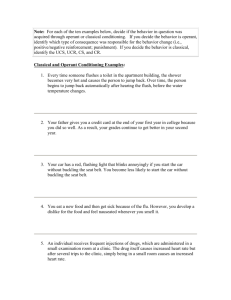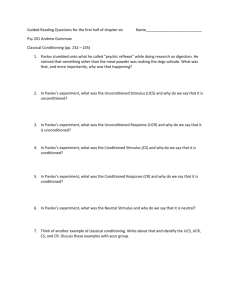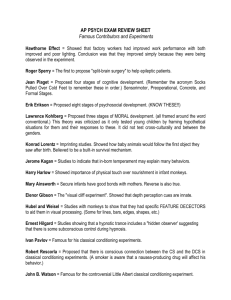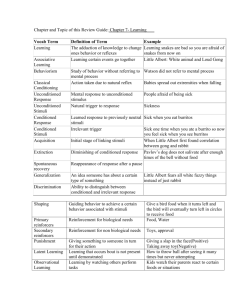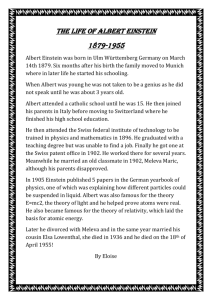Behavioural Explanation of Phobias
advertisement
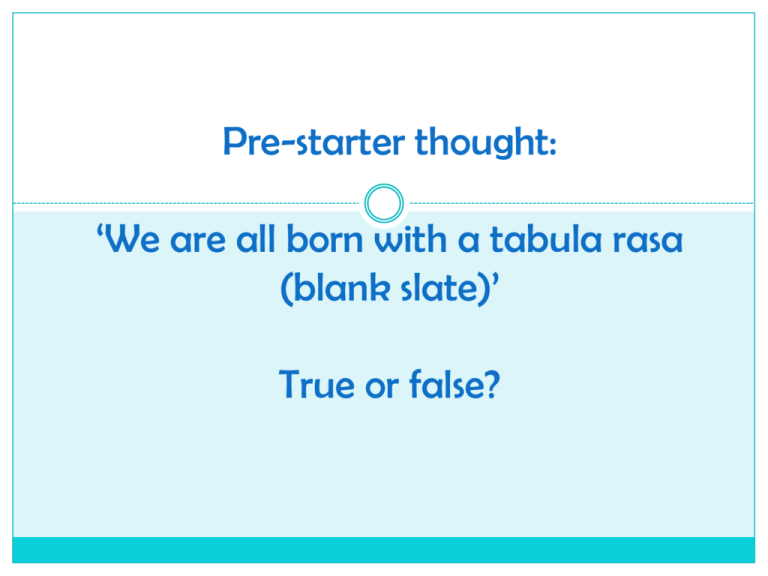
Pre-starter thought: ‘We are all born with a tabula rasa (blank slate)’ True or false? Recapping the behaviourist principles. THE BEHAVIOURIST APPROACH All behaviour learned Shaped by the environment Classical conditioning – stimulus-response/associations (Pavlov) Operant conditioning – punishment and reward – reinforcers (Skinner) No real element of cognitive involved Bandura – extension of this e.g. vicarious reinforcement Pavlov’s Dogs – Classical Conditioning According to this theory there are certain unconditioned stimuli, that elicit an unconditioned response. E.g. Food (UCS) salivation(UCR) It is possible for a neutral stimulus (e.g. a bell) to become associated with the unconditioned stimulus. Pavlov trained the dogs to associate the neutral stimulus (bell) with food (UCS) making it a conditioned stimulus (CS). CS CR Bell salivation Source: psychlotron Q. Explain how classical conditioning occurred in Watson and Rayner’s study. You may do this through words or images. Operant Conditioning When behaviour is moulded/shaped through reward and punishment, not merely association. Come up with your own examples in pairs. Positive Reinforcement • • • • • • Sweets Money Affection Praise Promotion Recognition Negative Reinforcement Removal of aversive stimuli • Parents stop nagging when room tidied • You didn’t get sunburnt when you wore suncream Positive Punishment • • • • Fines e.g. speeding Detention Smacking Telling off Negative Punishment • Being grounded • Taking away merits or house points • Taking toys away Recap and clarification Aim To demonstrate that the principles of classical conditioning can be used to explain how humans acquire phobic behaviours and to show that a fear response can be created within a young child to a stimulus which does not naturally produce this response. Procedure Although only carried out on one participant (a healthy, 8 month old male infant called ‘Albert B’ or little Albert) this is an example of a case study and an experiment. The procedure involved 3 phases: pre conditioning testing, conditioning trials and a post conditioning test. Pre conditioning testing Albert’s response to several stimuli was noted. The stimuli included a white rat, a loud noise, burning paper, a dog and a monkey. Conditioning trials At 11 months old Albert is again presented with the white rat. Every time he reached for the rat a loud noise was made. (The loud noise was made by striking a hammer against a steel bar behind Albert’s head). This process was repeated many times over several weeks. Post conditioning test The effects of the conditioning was tested by showing Albert the rat on its own and monitoring his reaction. Results In the pre conditioning trials Albert only showed the fear response to the loud noise. He showed no fear to all other stimuli. Results In the post conditioning tests the following observations were made about Albert: After the first trial Albert showed some distress. After the second trial he seemed suspicious of the rat. After the third trial he leaned away from the rat and when the rat was put next to him he started to cry. Results 7 weeks later Albert cried in response to a number of similar stimuli such as the fur collar of a coat and Santa’s beard. (Generalisation) Conclusion Watson & Rayner concluded that it is possible to produce a fear response (phobia) in a human using the process of classical conditioning. After the study…….. What happened to Little Albert? Watson wanted to desensitize him to see if a conditioned stimulus could be removed, but knew from the beginning of the study that there would not be time. Albert left the hospital on the day these last tests were made, and no desensitizing ever took place, hence the opportunity of developing an experimental technique for removing the Conditioned Emotional Response was then discontinued. "Albert B." was a pseudonym for Douglas Merritte. The boy died on May 10, 1925 of hydrocephalus. Evaluation Generalisability However, as this was a study of one young child the findings cannot be generalised to others. Albert had been reared in a hospital environment from birth and he was unusual as he had never been seen to show fear or rage by staff. Therefore Little Albert may have responded differently in this experiment to how other young children may have, these findings will therefore be unique to him. Evaluation Reliability The study is high in reliability as the use of standardised procedures allows for high control over all extraneous variables, this means that it is possible to replicate the study and check that the results are consistent. Evaluation Application to everyday life This research has demonstrated that phobias can be learnt through the process of classical conditioning. Therefore, if we can understand how phobias do develop we can incorporate this into treatment of this form of behaviour through the use of systematic desensitisation. Evaluation Validity This research lacks ecological validity, so the findings cannot be generalised to other settings outside the laboratory situation as the method used created an unnatural situation which may not reflect learning in everyday life. However, this artificiality did increase the experimental validity of the study due to the strict controls, e.g. Albert had no prior learning due to his age that could have influenced the fear response to rats. Evaluation Ethical issues There are ethical concerns with this study as Albert was conditioned to fear numerous white furry stimuli. His mother removed him from the experiment before the researchers were able to remove this fear. This goes against the present day guideline of protection which govern psychological research. However, you could argue that the benefits to others through the development of therapy outweigh the costs to Albert. Extra – credibility issue A recent (2012) research paper suggests that Merritte had hydrocephalus from birth. The article also included assessments of the boy in the "Albert B." film by a clinical psychologist and a paediatric neurologist indicating that his responses were indicative of a neurologically compromised child. If true, this would undermine Watson & Rayner's claim that "Albert B." was a "normal" and "healthy" baby and possibly call into question the credibility of a highly influential study. Group Activity A – Write 5 questions based on the aims and procedure of the study B – write 5 questions based on the results and conclusions of the study C – write 5 questions based on the evaluation of the study Write your qs 2. We will quiz in groups 1. Homework Research the following: The cognitive explanation for disorders in general DiNardo’s study (see booklet) – the booklet is slightly lacking for this study, so you will need to supplement this with extended reading and research Due next lesson.

